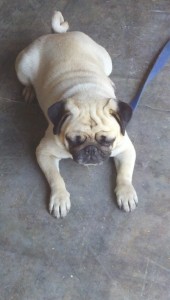This is why I’ve never had “inside pets.”
I’m currently babysitting a friend’s pug, which goes by the name of “Boris.” He snorts, he wheezes, he runs around in the most confused manner possible, and is generally a bit of a nuisance, but he’s adorable and loving, so who can hold that against him?
Well, as anyone who’s ever had inside pets can tell you, eventually your furniture gets peed on. And, as luck would have it, Boris peed on my wood bathroom vanity. This is ‘lucky’ only in the sense that I now have something new to talk about on my vanity blog, and, I suppose, also in the sense that I learned something new.
Dog urine can wreak havoc on wood products, be it hardwood flooring or wooden furniture. It seeps into the grains and can leave permanent stains – and, if you’re not quick to do something about it, permanent smells (By the way, here’s some advice on how to protect wood floors from dog urine).
So, as soon as I realized that Boris had made a no-no on my vanity leg, I quickly went to work consulting the wisdom of the internet for advice. This is what I found, and the plan of action I ultimately executed, with phenomenal success:
- FIRST – clean up the area immediately using an absorbent rag. Paper towels are ok too, but are a bit inefficient since they tend to break too easily and you will likely end up going through several sheets before the soppy mess is dried up. Some sources recommend diluting the fresh urine with water before cleaning up as it makes it easier to absorb.
- NEXT – Apply a simple solution of one-part vinegar to one-part water to the affected region. This works for wood as well as carpet or any other pee-stained surface. The vinegar will neutralize the strong ammonia odor of dog pee, and it also serves as an antibacterial agent (as it turns out, ammonia smells are strongest when the stains they come from are allowed to age and harbor bacteria – also, ammonia reacts with water and lets off a smelly gas that can only be described as “that pee smell,” but vinegar, again, neutralizes this). Rinse off the marked area and let the vinegar soak into the wood for a bit. My sources all suggested letting the vinegar solution linger for about five minutes.
- THEN – while the vinegar solution is still a bit damp, try rubbing in a pinch of baking soda. This will de-odorize the area even further. Let it dry out, and then remove it with a dry towel or rag.
This is as far as I went, and it did wonders for me! The smell was completely gone, my bathroom vanity looked as good as new, and Boris gets to continue his stay as my guest! It’s a good thing I caught the urine early before it did any real damage to the wood.
So, if nothing else, I hope you take away this lesson from my plight: always, always, always be prepared! Oh, and try to make sure your bathroom vanity is properly sealed so pee just drips off the cabinet, rather than becoming a permanent addition to the “unique character” of your vanity.
Did you like this article? Read more of my blog, or follow me on Twitter!
UPDATE! Today, August 2, 2011, I have discovered something that I really, really wish I had discovered earlier: Behold, The Clean and Green Pet Odor and Stain Remover! It’s won several esteemed awards, and it is supposed to totally kill pet odors and remove stains. They have material-specific aerosols… I wish I had the wood finish aerosol handy when Boris made his fateful leg-lift! Oh well… next time I babysit the feisty pug, I will be ready!

Thanks for the info on that. I wrote it off as yet another price, but I am going to have a look at it once more.